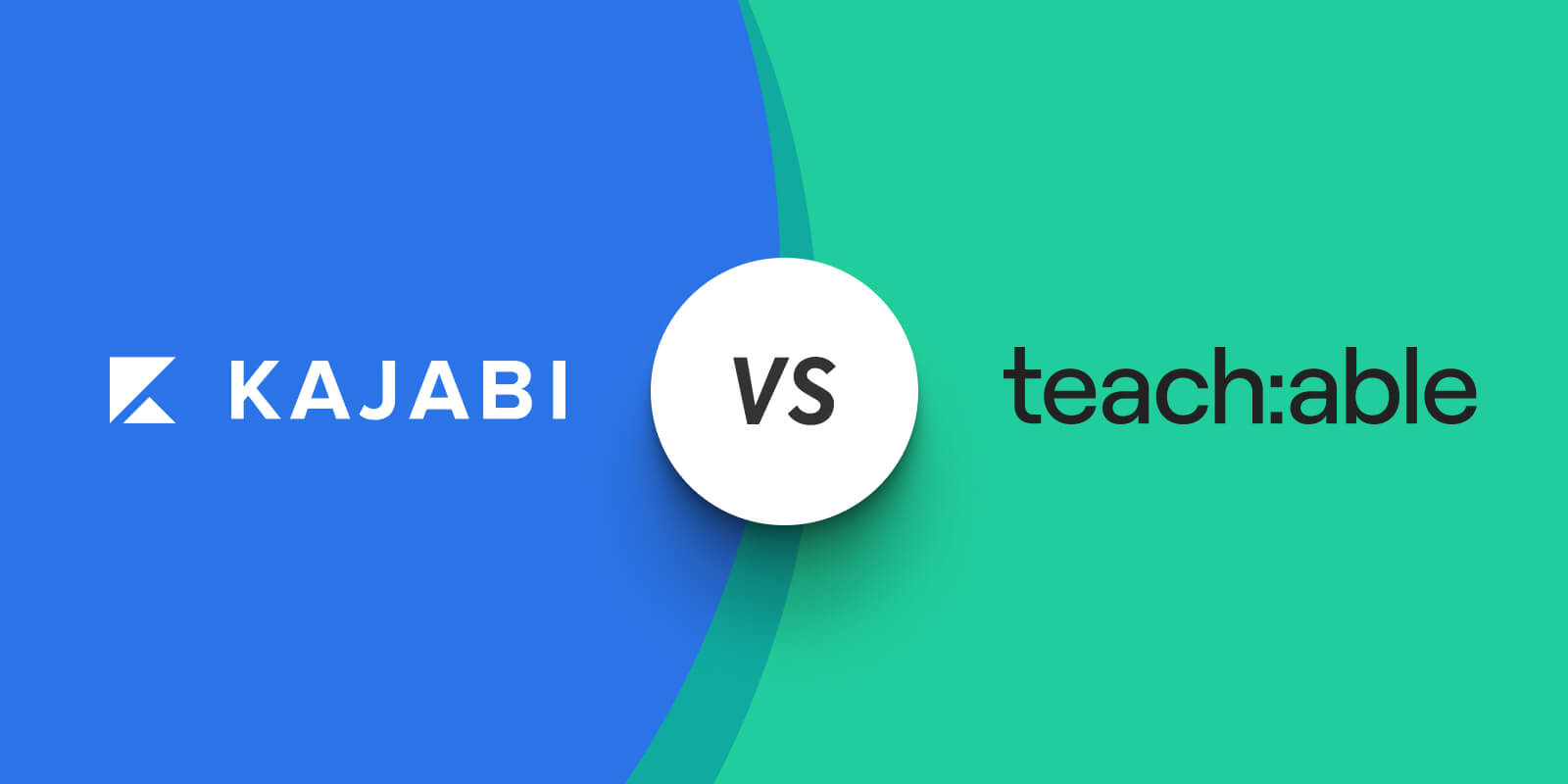Table of Contents
Whether you’re a creator, a life coach, or a digital creator, creating a course is one of the best ways to grow your online business.
Kajabi and Teachable are major course platforms in the space with tens of thousands of users. Both have their advantages and disadvantages, depending on the use case you need them.
Kajabi is an all-around marketing & business platform, able to deliver in many circumstances, while Teachable is more suited to creators & coaches just starting with online courses.
We tested both Teachable & Kajabi to determine which is the best platform for your courses, and compared different features for you.
This comparison guide to Teachable vs. Kajabi provides a detailed overview of each tool, making it easier to get your online course business off the ground.
Table of contents
⚠️Disclosure: Information on pricing, customer support, and customization options comes from public-facing pages on the Kajabi and Teachable websites. Some features mentioned in this review may only be available if you purchase a top-tier paid plan.
The review and screenshots were created by subscribing to the lowest level of each software for a month and extensively testing the software. It also includes comments and opinions created with years of experience as a competitor in the elearning ed-tech market.
LearnWorlds is a direct competitor with both Teachable and Kajabi. LearnWorlds is the superior software for creating, marketing, and selling online courses. It is the choice of entrepreneurs, educators, and businesses who genuinely care about delivering a better experience for their learners, employees, and customers.
Our Top Choice: LearnWorlds
Kajabi and Teachable both possess commendable qualities, but if your goal is to provide the ultimate learning experience to your students, LearnWorlds stands out as the ideal choice!
LearnWorlds has everything you need to create, manage, and sell online courses on any topic.
It has more advanced elearning features like SCORM support, reporting & analytics, full website-building capabilities, a robust course builder, and learning & marketing automations.
Also, LearnWorlds puts its customers on a pedestal with industry-leading support.
When you sign up for LearnWorlds, you’ll get the best online course platform available in the market, freeing you from technical complications as you focus on growing your business.
Try LearnWorlds with a free 30-day trial; no credit card is required:
Your professional looking Academy in a few clicks
Start FREE TrialIn a Nutshell
Teachable is an online course platform that allows you to create courses and offer one-on-one coaching.
In contrast, Kajabi is an all-in-one marketing platform for course creation, podcasts, group coaching, individual coaching, and membership sites.
LearnWorlds wins by far in Course Authoring, Features, Customer Service, and Value for Money.
In our review, Kajabi scored better in marketing, and website-building capabilities, while Teachable has better course authoring, is easier to use, and is cheaper to start with.
LearnWorlds wins by far in Course Authoring, Features, Customer Service, and Value for Money.
In-Depth Comparison of Kajabi vs. Teachable
Kajabi is primarily an all-in-one marketing platform with many more marketing and sales capabilities than Teachable, but it lacks educational features.
Starting from pricing, Kajabi tends to be more expensive as Teachable offers a free plan that supports unlimited students. Teachable’s free plan is a budget-friendly option to create a single course with just a few videos.
Kajabi offers a free 14-day trial with a required credit card 🛑 but no free plans. If you like the platform and want to keep using it after the trial expires, you must sign up for a Kajabi subscription.
Both platforms allow you to offer free and paid courses, set up recurring payments for memberships, and create a free or paid community for your audience.
Both have their proprietary mobile apps. Your learners can download the app and access your courses from a smartphone. However, the Teachable app is only available on iOS devices. Kajabi’s app works on iOS and Android.
Lastly, Teachable started focusing on education and shifted towards coaching, making it more educator-friendly with more options when creating educational courses, quizzes, and assessments.
On the other hand, Kajabi offers the basics you need for a video course structure with knowledge checks but needs more advanced learning features & analytics for more demanding educators.
Kajabi or Teachable: which is better?
It depends on whether you’re looking for a proper learning management system or a course creation tool packed with marketing features. Teachable is the better option for coaching products, while Kajabi is ideal for users who focus on sales and digital products rather than courses.
But, if you are serious about education, LearnWorlds is a better choice than both.
Kajabi Overview
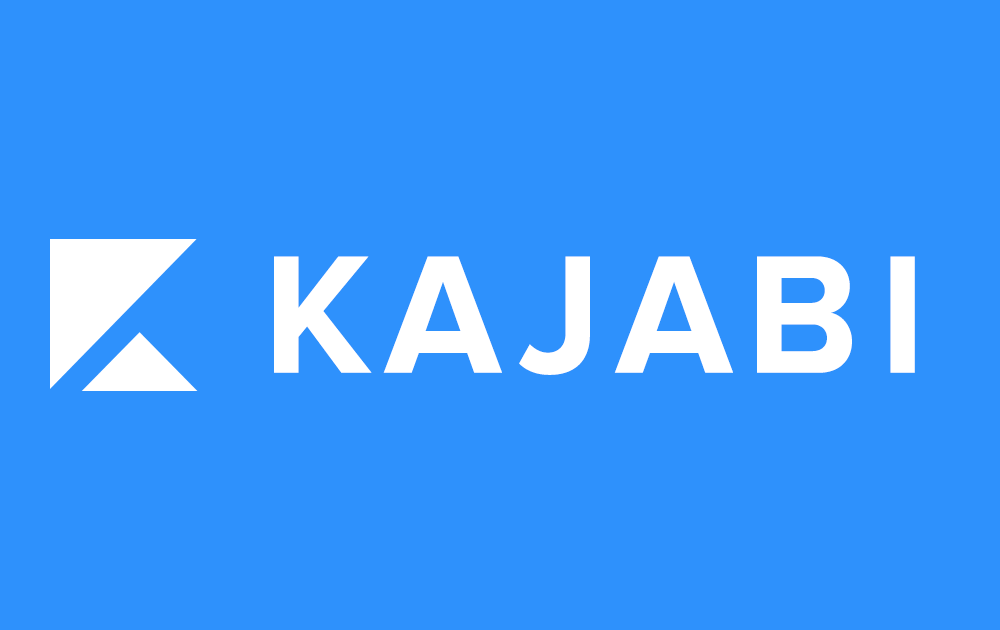
Pros
- Easy to use
- Robust marketing tools
- Integrates with popular software packages
- It comes with tools for building sales funnels/pipelines
- Access to a built-in community (purchased Vibely, a community platform, in 2022)
- Ready-made templates
Cons
- No free plan once the trial expires
- Few design customization options
- Course authoring tools aren’t as advanced as they could be
- Limited learning features
- Emphasizes product sales, not the learning experience
- Lack of elearning reporting & analytics
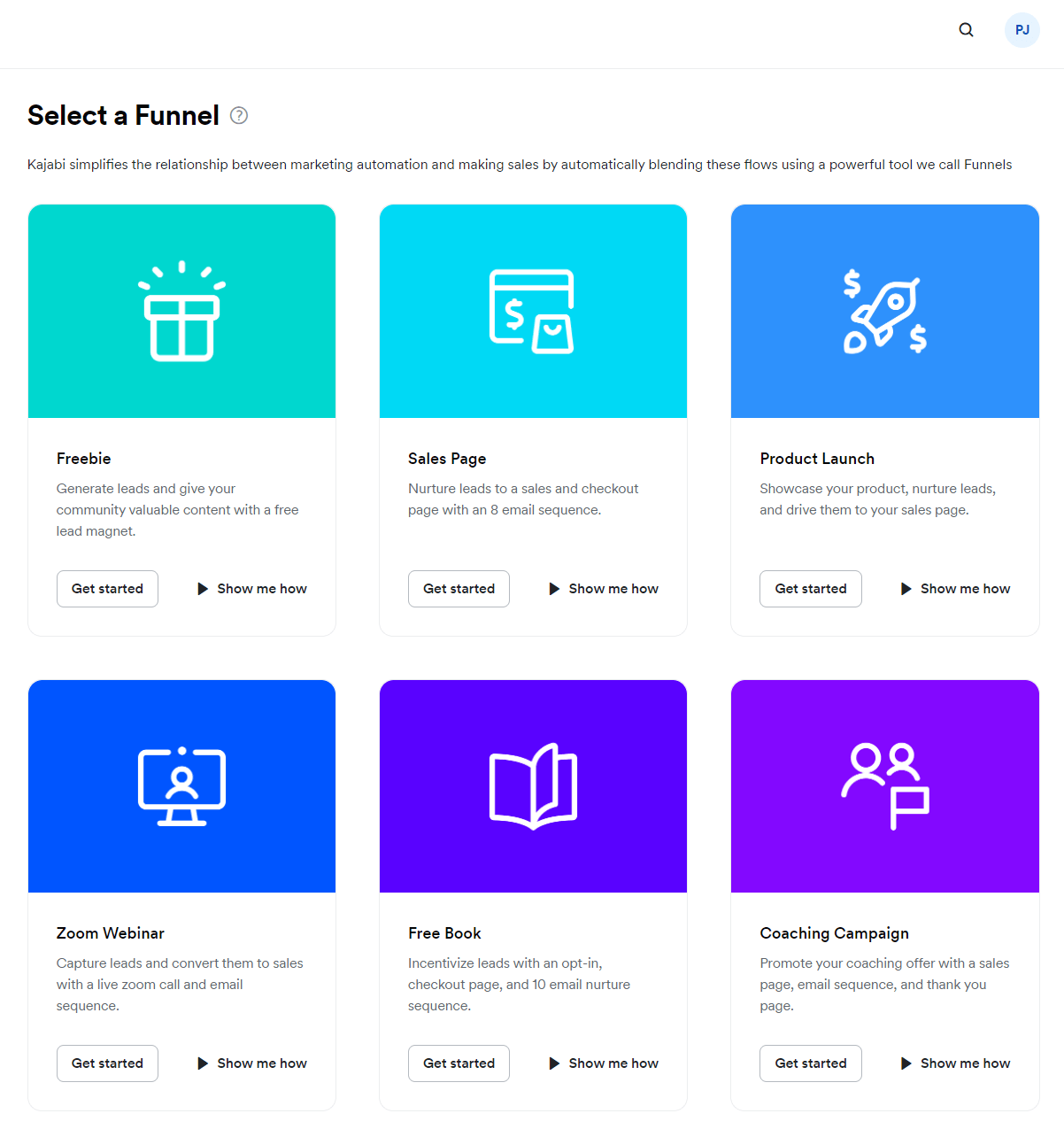
Kajabi Pricing
Kajabi is the most expensive course platform at $149 per month. All prices below are for monthly plans, and you can save 20% if you pay annually:
Basic plan: $149 / m
Growth plan: $199 / m
Pro plan: $399 / m
*Pricing retrieved in June 2023 from Kajabi’s pricing page.
Who Is It For?
Kajabi is for digital entrepreneurs, business owners, and online course creators who want access to a full suite of digital marketing tools. The platform is ideal for “non-techy” users interested in scalability.
💁 Read Kajabi vs. LearnWorlds to see how Kajabi stacks up against our top choice for eLearning software.
Teachable Overview
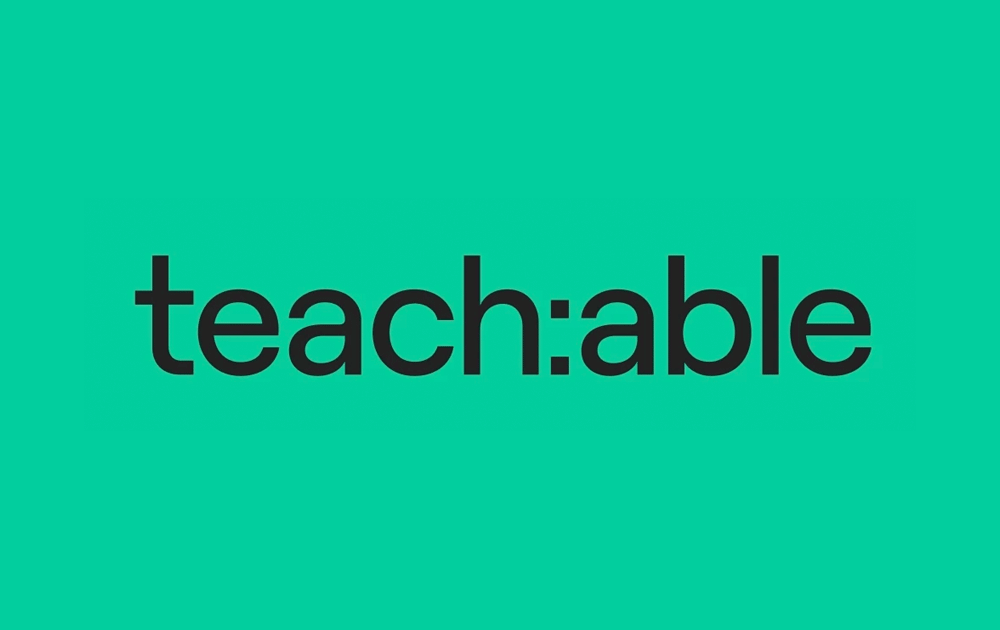
Pros
- Free plan with limited features
- Includes all the basics you need to get started
- It comes with a landing page builder
- Loaded with sales and marketing tools
- Third-party integrations available
- Provides 24/7 customer support
Cons
- Very high transaction fees for the free plan
- Limited website customization
- Doesn’t include advanced course authoring features
- No live chat support
- Emphasizes sales features instead of learning
- Doesn’t support TinCan, SCORM, or AICC
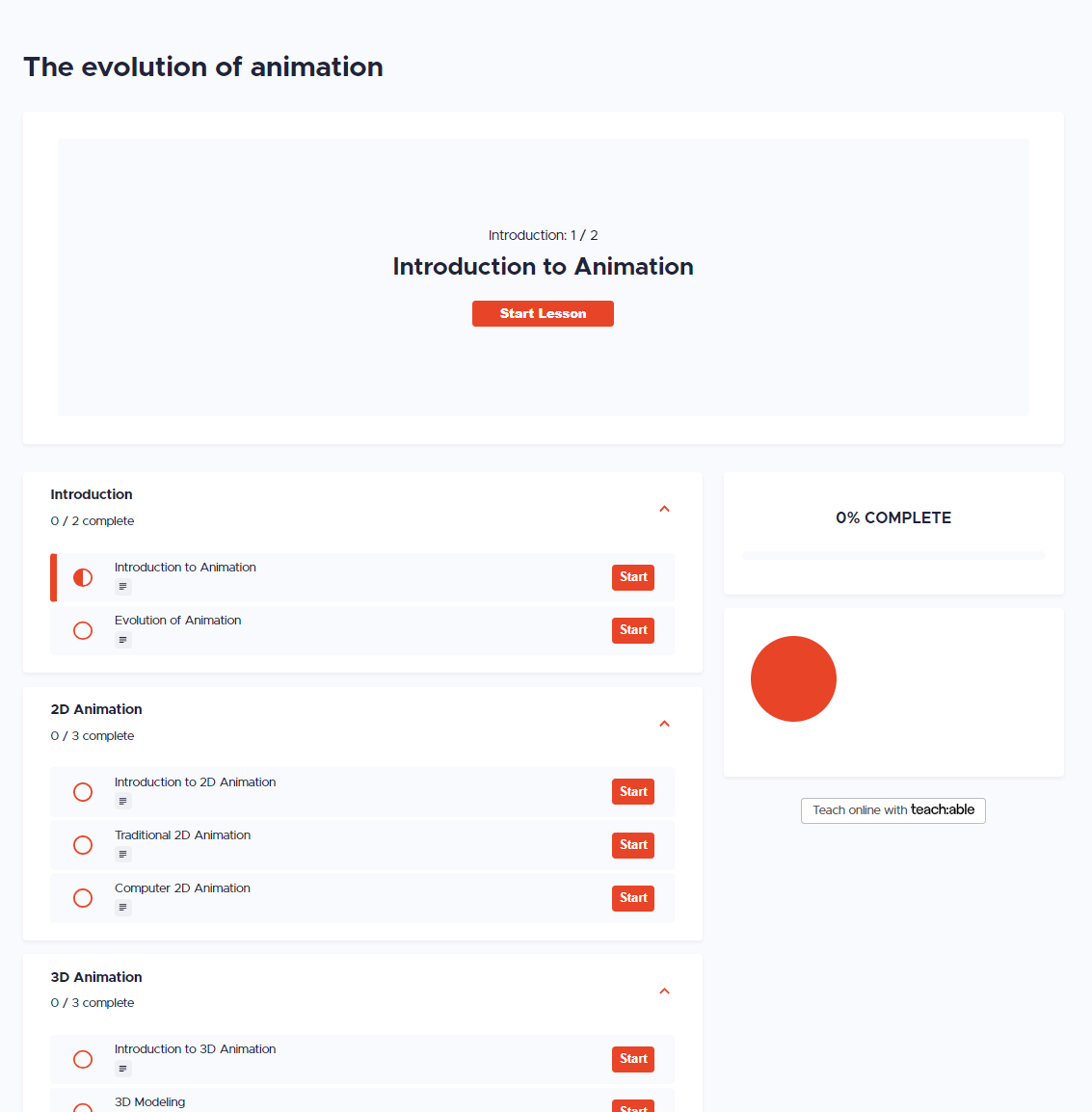
Teachable Pricing
Free plan: $1 + 10% transaction fee
Basic plan: $59 / m + 5% transaction fee
Pro plan: $159 / m + 0% transaction fee
Business plan: $655 / m + 0% transaction fee
*Pricing retrieved in June 2023 from Teachable’s pricing page.
Who Is It For?
Teachable is ideal for new course creators. It’s also a good option for coaches, solopreneurs, and creative professionals who want simple video courses and booking-style coaching features.
Teachable isn’t a feature-packed platform, and it’s really easy to use, so it’s great for users with basic tech skills. However, if you have extensive experience with course creation, you may find it lacking in educational capabilities.
💁 Read Teachable vs. LearnWorlds to understand why LearnWorlds is a better option for course creators.
Ease of Use
Both Kajabi and Teachable are easy to use and do not require any special skills to use. Teachable’s interface is slightly better and more friendly than Kajabi as it comes with fewer features.
The first thing you will see in Teachable is a dashboard guiding you on the steps you need to take and support resources. Kajabi shows a long list of feature categories to choose from. For a new course creator, this might be overwhelming.
Building a course in Kajabi is also intimidating at first glance, but you can easily get the hang of it after some playing around with it. Kajabi uses the wording “products” as you could have a downloadable ebook, single video, or even podcast as a product.
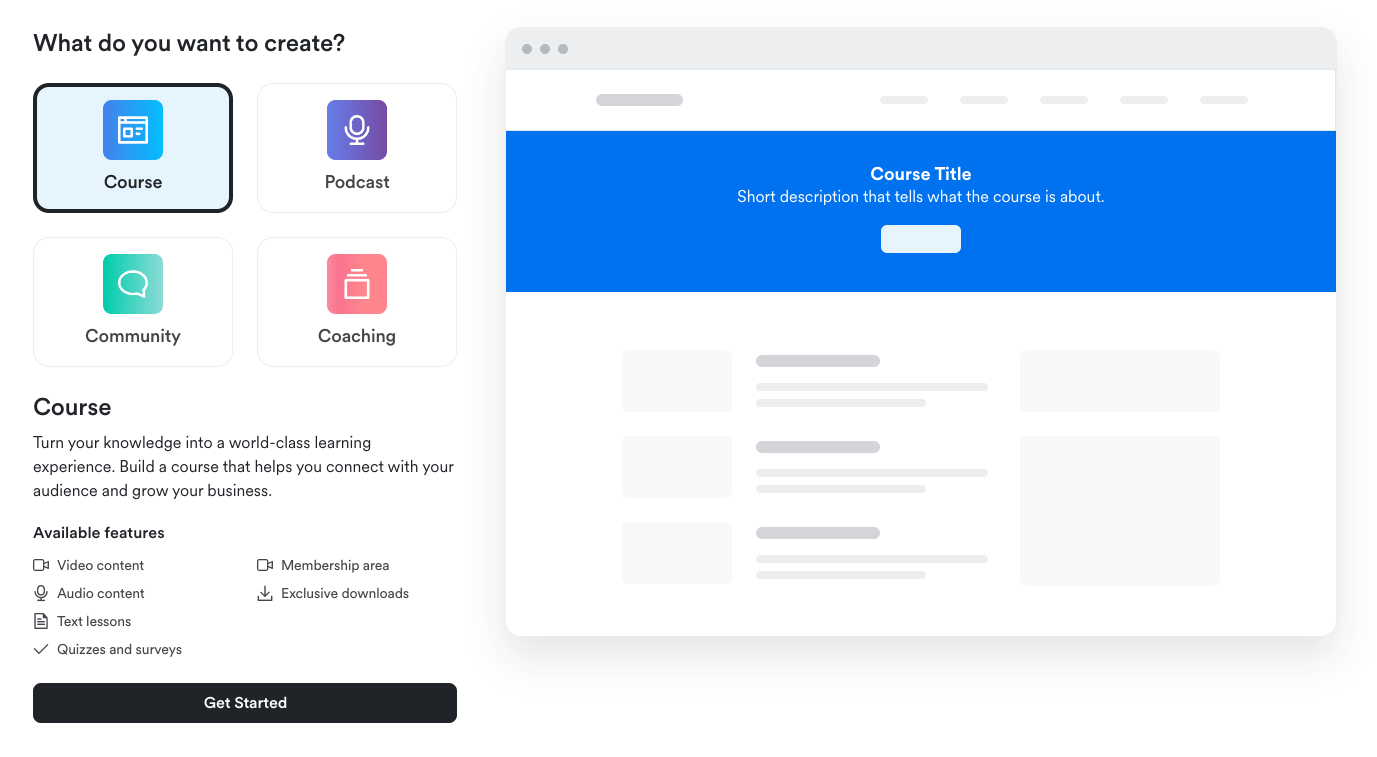
Teachable offers an easier course creation interface, and the addition of the AI course outline generator makes it a breeze to create your first course learning units.
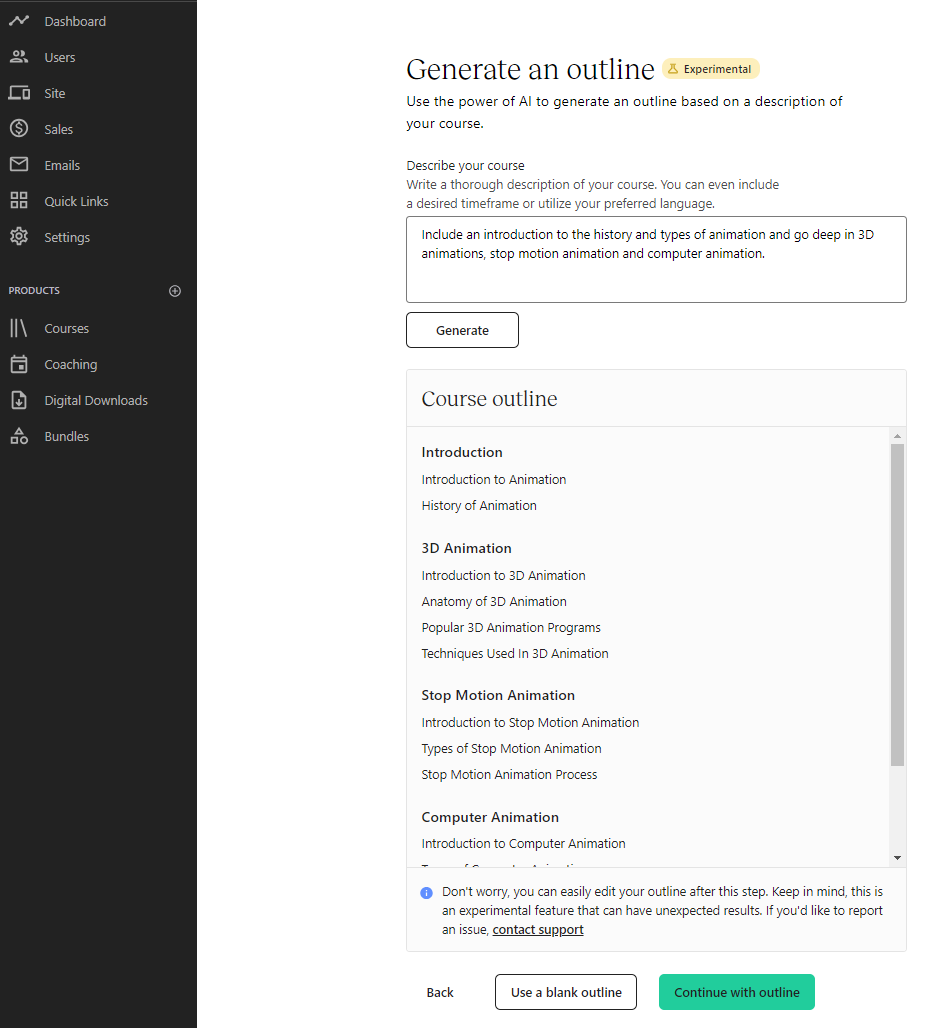
All that said, Teachable is a better choice for new course creators who may not have fully fleshed out their courses yet, while Kajabi is geared more toward experienced creators who know what they are doing.
Then, building your website and landing pages and setting up your marketing emails and sales follows a similar approach, with both platforms having easy-to-use simple interfaces and point-and-click or drag-and-drop features around.
The best part is that both come with templates to easily create your course website. The only downside is that creating a beautiful website requires some design skills, and if you want to customize the code on Teachable you will need to purchase the higher plan.
Course Creation (Authoring)
Both Kajabi and Teachable promote themselves as course platforms where you create and sell online courses as their primary functionality.
Below is a review of both platforms’ course creation functionality and a more in-depth look at some of the features.
Kajabi’s Course Creation
Kajabi comes with course creation templates based on different product types:
It also allows for several kinds of files and activities to be uploaded, such as video, audio, pdf, quizzes, community posts, leaderboards, and more.
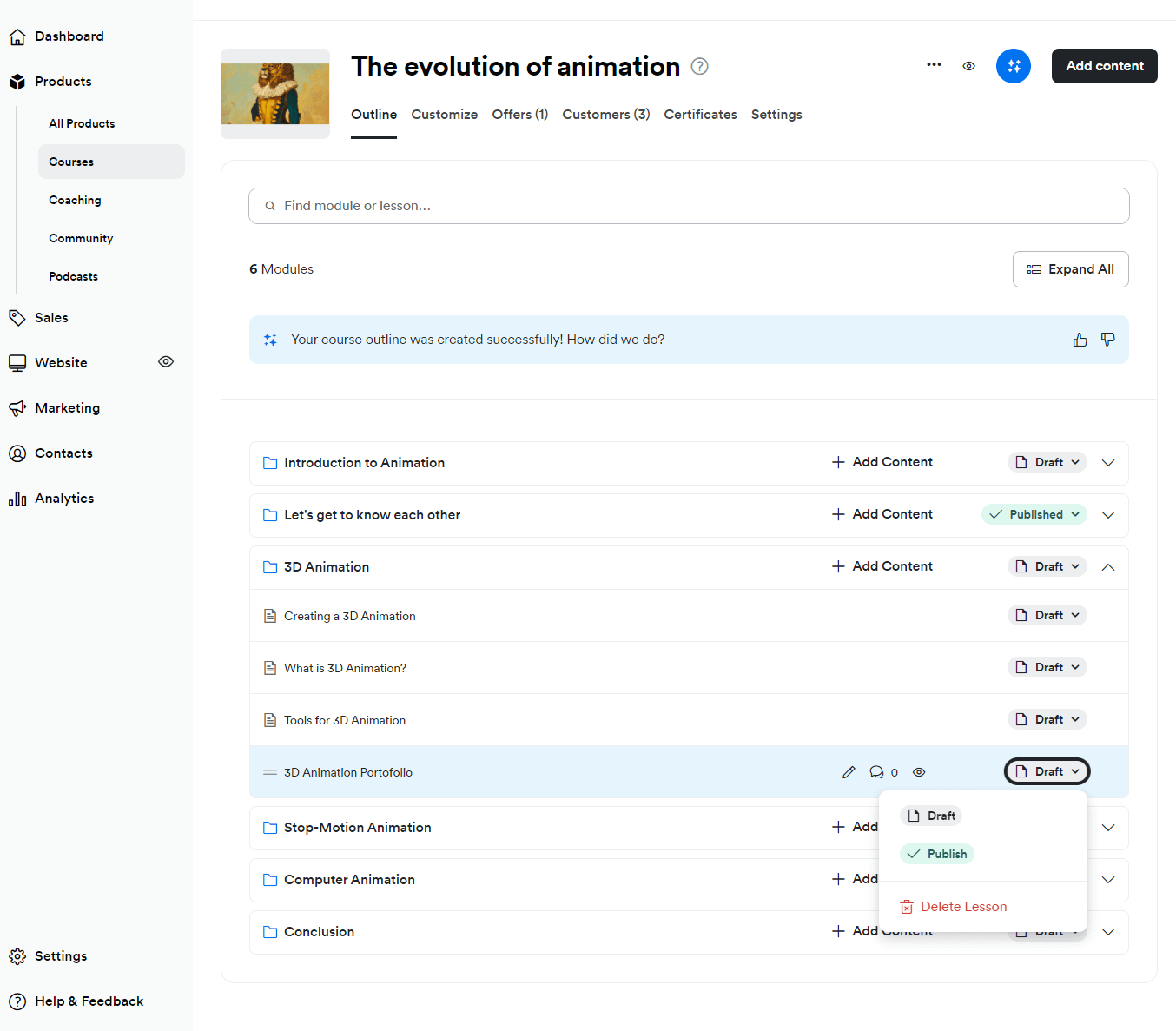
The downside of Kajabi is that those features sound great but need to be more complex. Quizzes are great if you offer a video course with some knowledge checks.
For advanced users creating serious training courses, Kajabi lacks educational features like advanced assessments, question banks, SCORM, and interactivity features.
Teachable’s Course Creation
Teachable has more authoring features than Kajabi, which is why we recommend it for users who want to focus on teaching and coaching over selling digital products.
What makes Teachable such a great platform for beginners is that it has an intuitive interface, making it as easy as possible to get your course up and running.
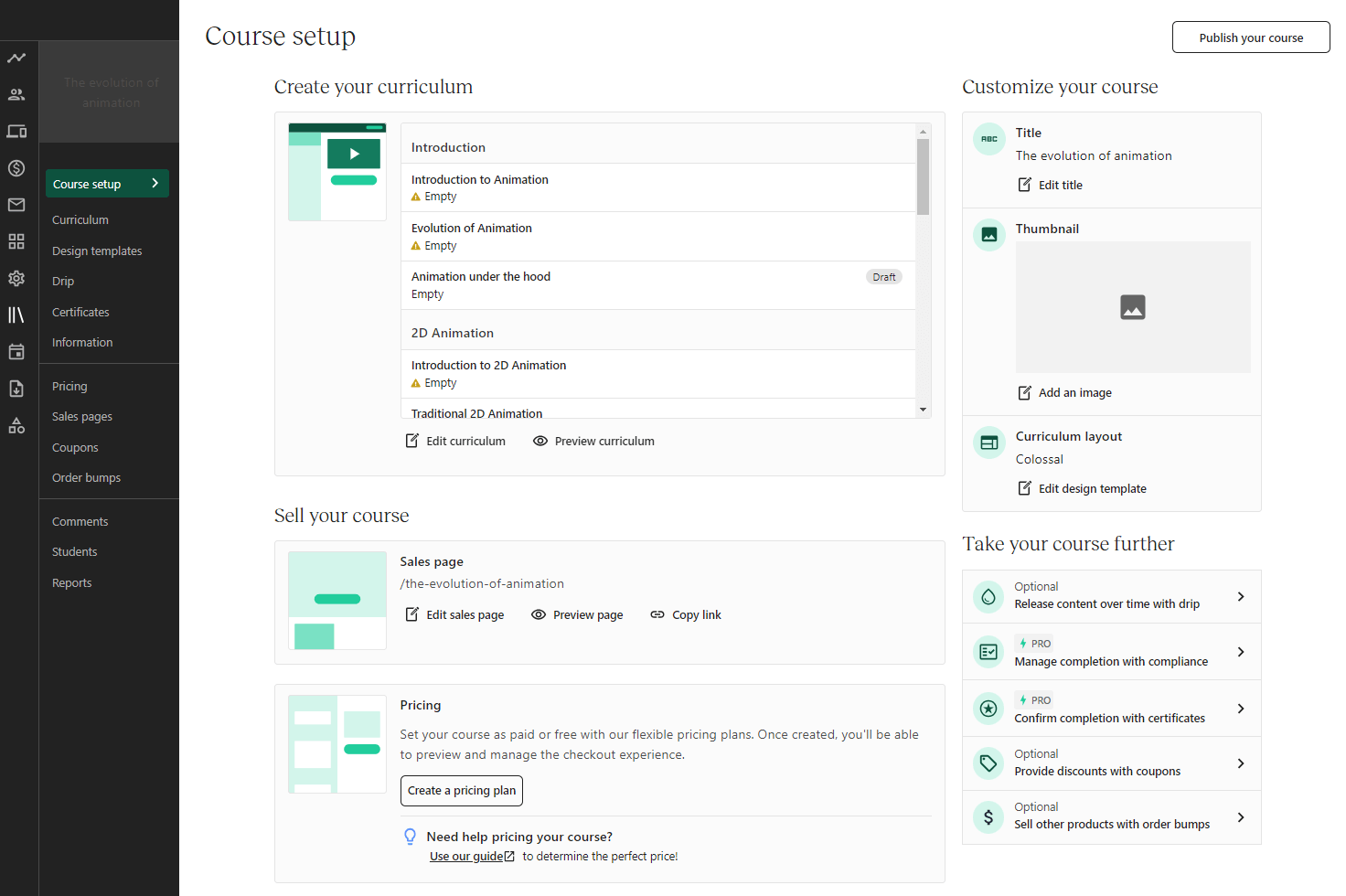
Teachable allows you to create rules regarding quiz completion, video watching, and lecture order, a more advanced feature than Kajabi’s category lock, which offers a linear progression path.
The platform also offers several templates for course completion certificates, making it easy to recognize your students’ achievements.
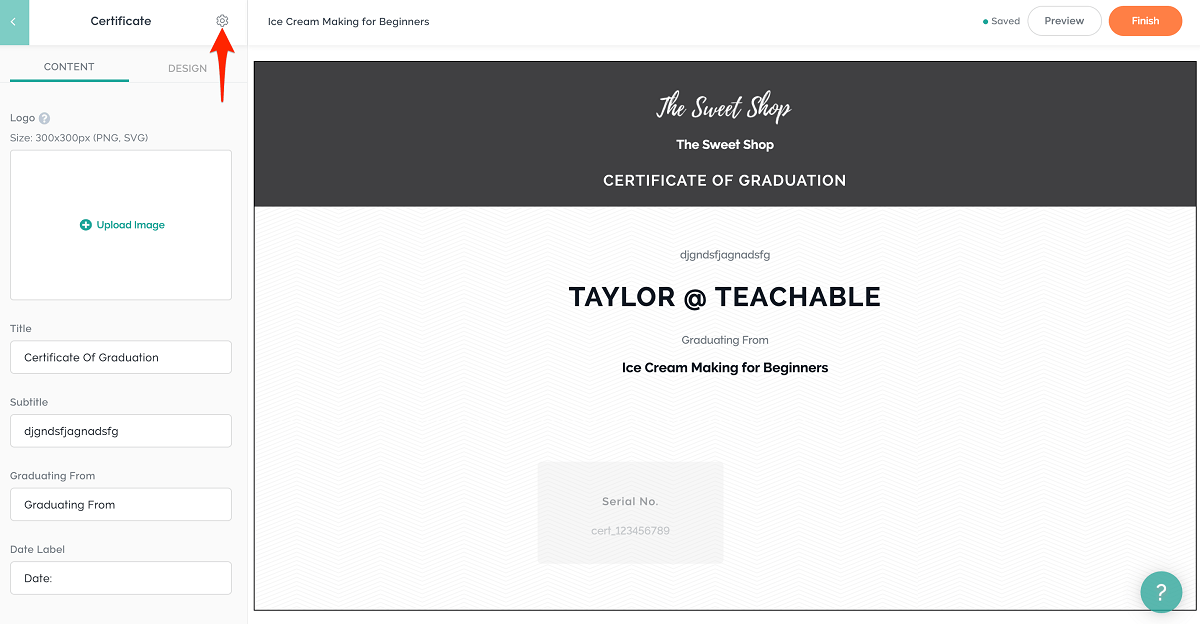
Assessments
The platform also supports multiple question types as assessments, including open-ended, multiple-choice, and fill-in-the-blank. You can give a passing score and see the quiz score at the reporting of the assessments.
You can also manually grade assessments for open-ended questions.
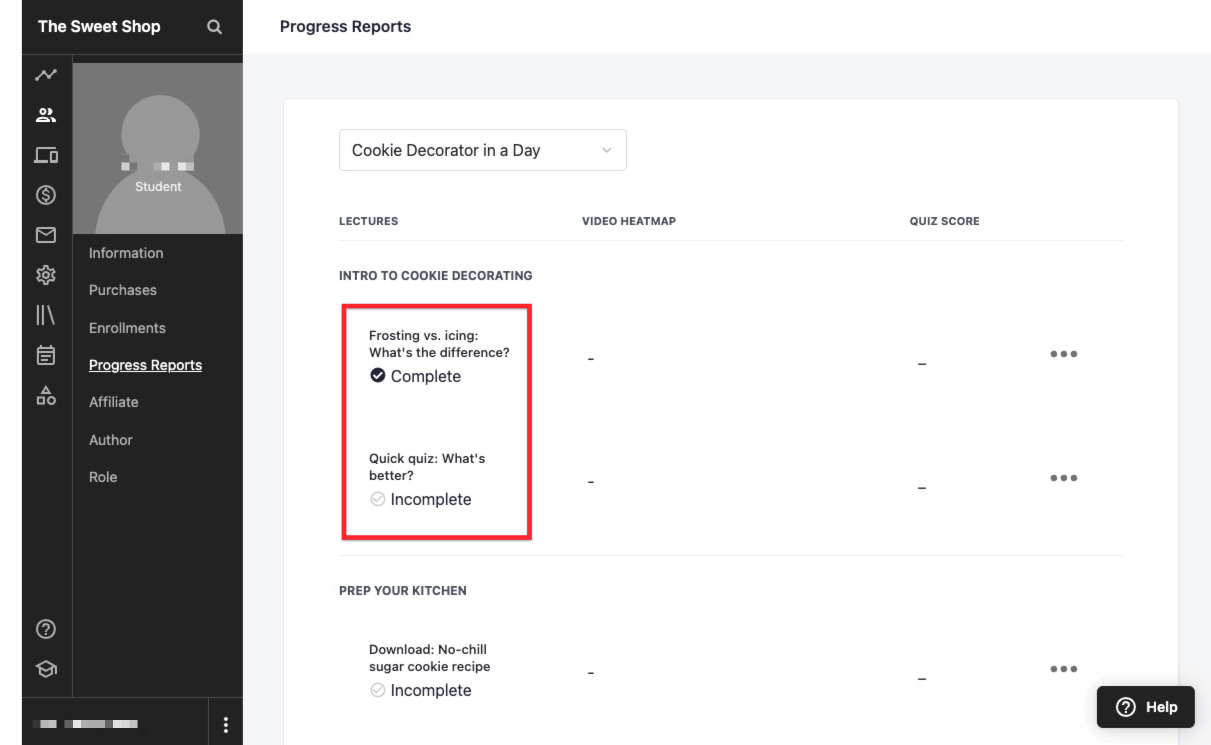
Teachable allows you to create graded and ungraded quizzes, but graded quizzes are only available with the Pro and Business plans.
Additionally, the platform doesn’t support many question types. If you don’t want to use multiple-choice questions, you’ll have to ask students to submit their responses in HTML or rich text.
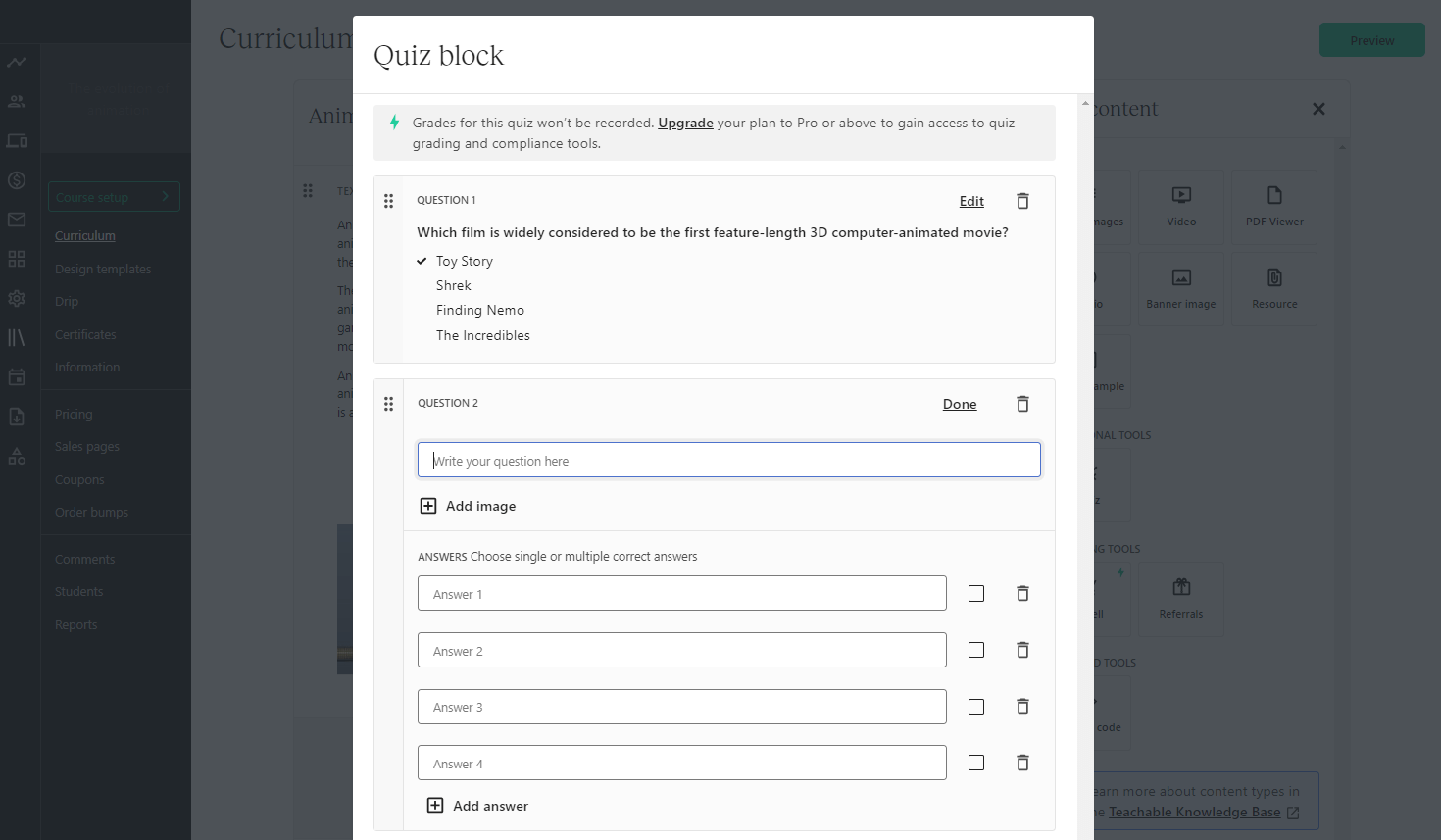
Community Features
Kajabi recently bought Vibely, a community platform, and has integrated it with their software, offering more advanced community-building features.
In the community, your members can create posts, answer comments, add photos, create discussions, send private messages, and challenges, and you can schedule meetups or live events.
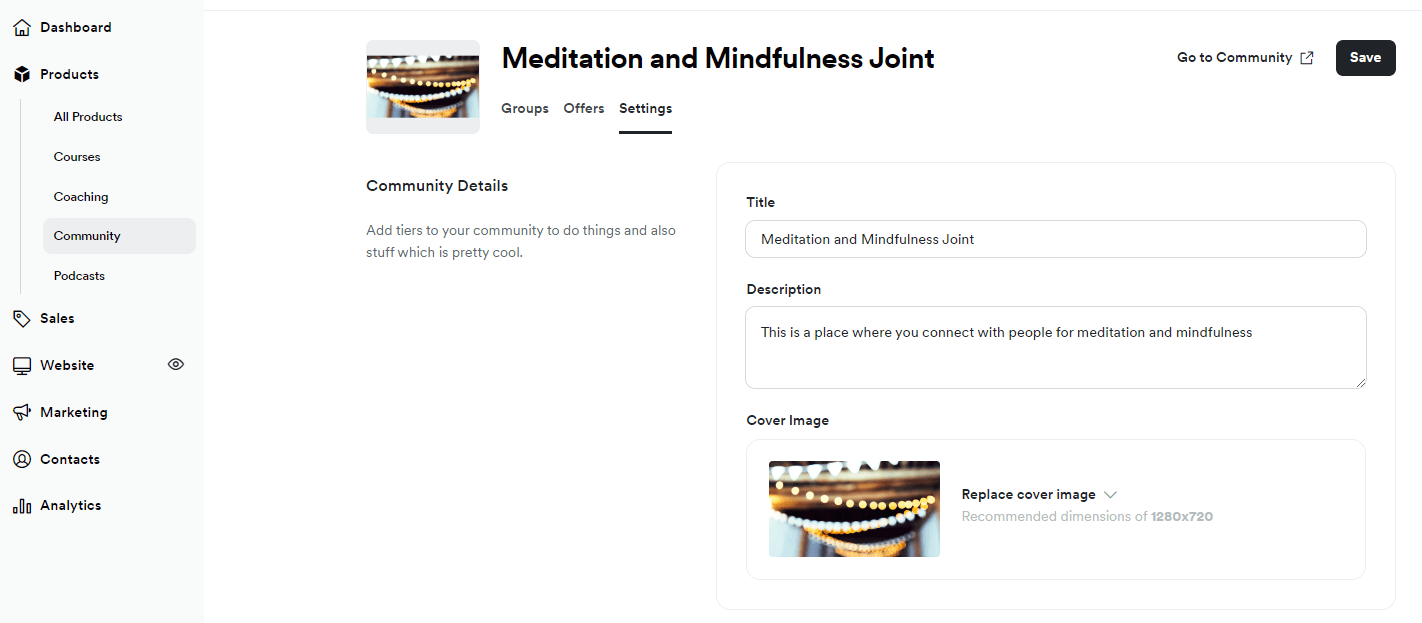
Teachable does not have a built-in community but has native integration with Circle.so. Circle was co-founded by the ex-VP of Product and ex-VP of Growth of Teachable, but it’s a different product, and you will need to pay extra for the community features it offers.
Analytics & Reporting
Kajabi offers in-depth analytics to help you identify your most profitable courses and keep track of enrollments. The Analytics Dashboard shows you how many people have enrolled in your courses and how much revenue you’ve earned.
Kajabi also has a sidebar showing your recent activity, such as net revenue, opt-ins, subscription metrics, page views, product progress, and offers sold.
It also offers video and audio engagement reports to monitor the progress of your students, but not much in terms of learning analytics.
Teachable, on the other hand, offers four course reports to better understand your students:
It also includes revenue reports, stats, and integrates with Google Analytics & Mixpanel to get a better view of how your school is performing.
Sales & Marketing Features
Kajabi’s funnels are one of its most powerful features in marketing and sales. You can create email marketing automations and combine it with trigger events such as a webinar, a landing page, or a checkout.
Kajabi comes with everything you need to build a marketing engine, such as lead capture forms, email sequences, a checkout system, various payment methods, landing page building, thank you pages, etc.
Kajabi is the undisputed winner in this category, and it’s often categorized as a marketing platform over a course platform because of these great features.
On the other hand, Teachable allows you to create an affiliate program, incentivizing current students to refer other people to your courses, offers built-in tools to track referrals and make sure affiliates get paid on time.
Teachable also allows you to create a dedicated page for each course and send mass emails.
The power of Teachable is its order bumps feature. While you can achieve a similar effect with Kajabi, on Teachable, you can offer a suggested “upsell” to your customer right on the checkout page, thus increasing your sales at the last moment.
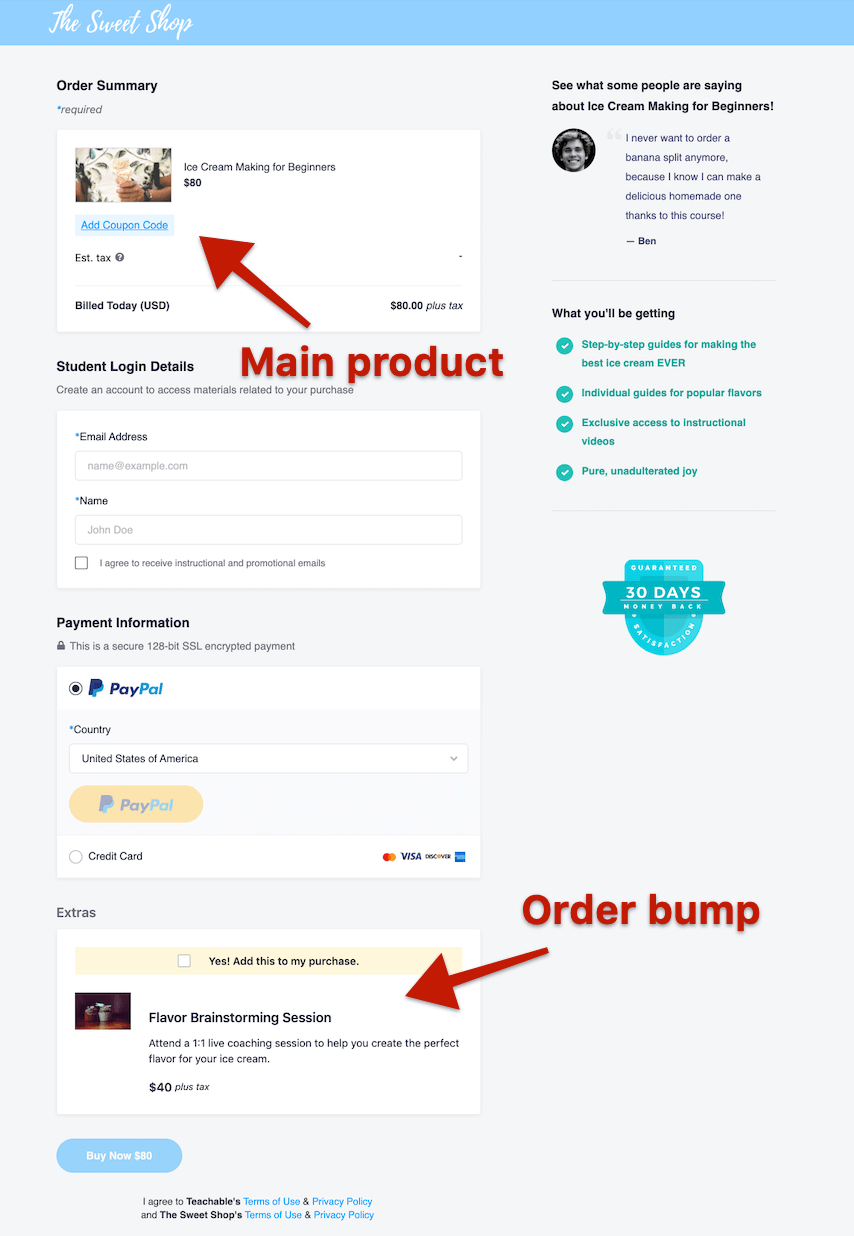
Email Marketing, Funnels, & Automations
Kajabi has built-in email marketing, eliminating the need to purchase and learn to use a separate tool. The visual editor comes with hundreds of templates, making it easy to create custom courses, preview them, and make updates as needed.
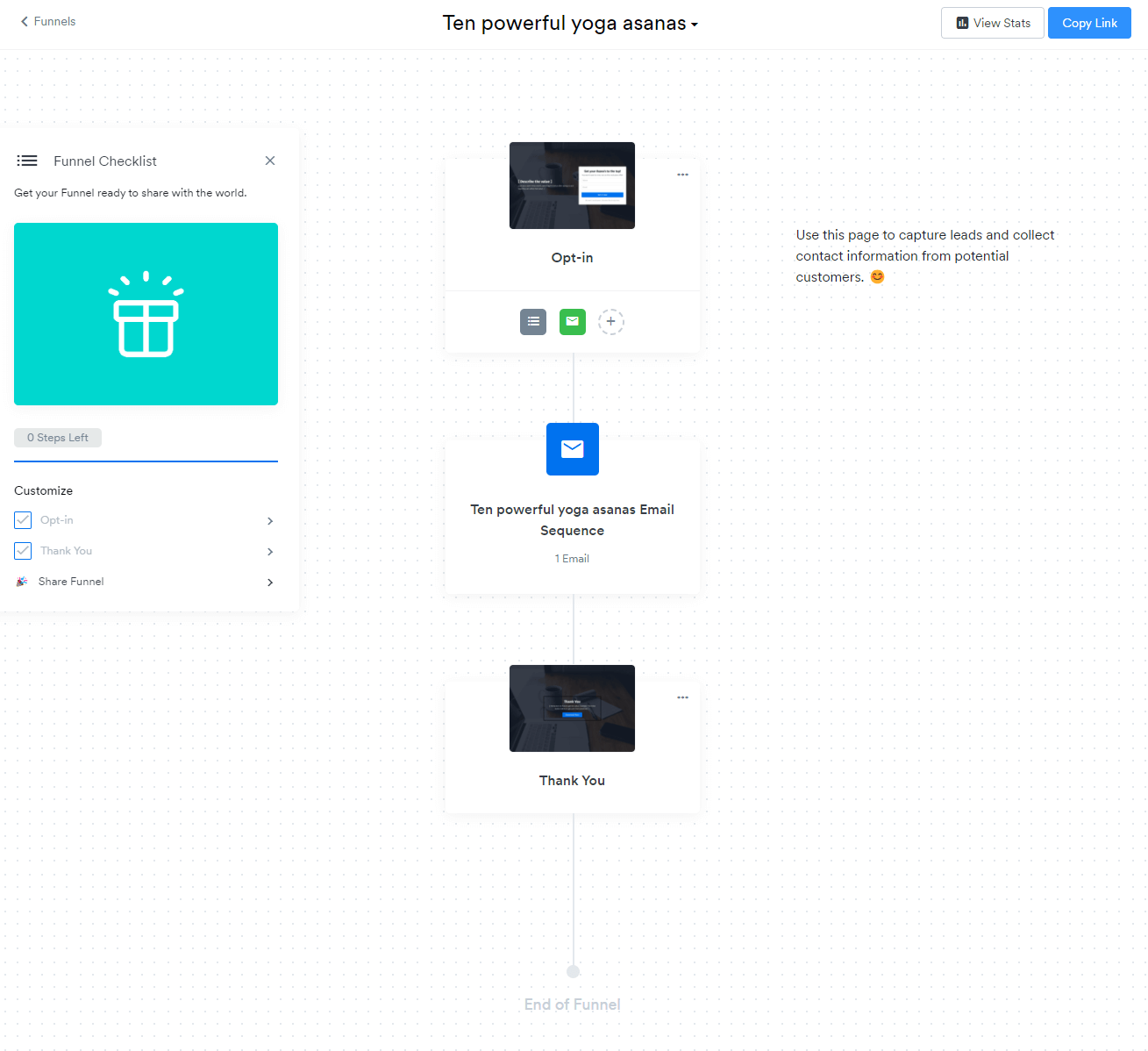
Kajabi also offers advanced email analytics to help you identify what’s working and what isn’t.
For example, you can see how many subscribers you have, what percentage of your emails are delivered successfully, and what percentage of recipients opened each email.
Kajabi subscribers also have access to automations designed to increase efficiency. These tools use if-then logic to streamline and trigger specific actions. For example, you can use automation to send a certificate of completion once a student completes a course.
Teachable is more limited, as it only allows you to send one-time emails to students. If you want to create effective email marketing campaigns, you’ll need to use ConvertKit, MailChimp, AWeber, or ActiveCampaign. Teachable also lacks many built-in automation tools, but you can use the Zapier integration to automate tasks between the course platform and other applications.
Kajabi comes with ready-made funnels, taking the guesswork out of nurturing leads and persuading them to sign up for a course, community, or membership site. The platform also has templates available for common tasks, such as product launches, giveaways, and webinars. You can even create a custom sales page for every program you create.
Teachable doesn’t have built-in funnel features, making it a little more difficult to generate leads, nurture them and turn them into paying customers. If you’re serious about growing your business, you can use ClickFunnels to complete these tasks, but that means you’ll have to learn how to use another tool.
Payments & Memberships
Teachable offers a number of payment options as well as its payment gateway: Teachable:Pay.
With Teachable, you can have four pricing options:
These options give you flexibility on how to price & sell your products, and subscriptions allow you to offer a membership option for your students if you are selling a community.
Membership sites with different subscription levels are ideal for course creators who teach students with different skill levels.
For example, if you’re a clarinetist, you can set up a membership that includes every beginner, intermediate, and advanced course you’ve produced.
Teachable was also one of the first course platforms to offer its own payment gateway. Unfortunately, it’s not available in every country and comes with pretty high fees, especially if you are not in the U.S. (retrieved from Teachable’s support pages):
| Payment method/type | Fee |
|---|---|
| US Card fee | 2.9% + 30¢ |
| US PayPal fee | 3.49% + 49¢ |
| International card fee | 3.9% + 30¢ |
| International PayPal fee | 4.99% + 49¢ |
Kajabi has released a beta version of its own payment gateway this year, Kajabi Payments, but it also integrates with Stripe & PayPal for payments.
Kajabi Payments is available only to select customers in the U.S. and costs 2.9% + 30¢ per transaction, and adds additional fees as:
Kajabi also offers similar features to Teachable where you can set one-off payments, installments, or subscriptions. Combining the subscriptions with its new community features, makes it easy to offer memberships.
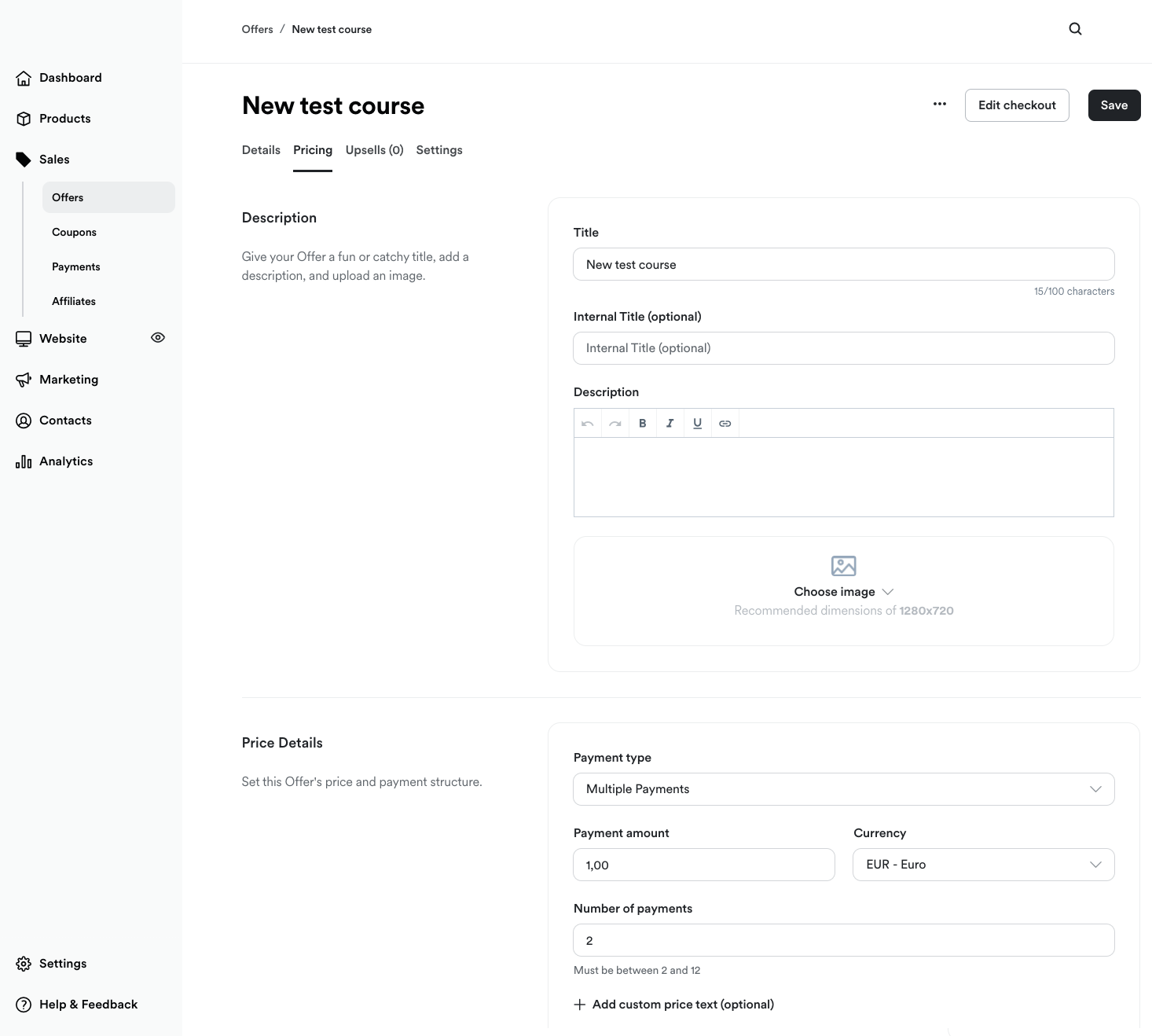
Kajabi vs Teachable on Building a Website
Both platforms offer a website builder focused on creating landing pages, login screens, and checkouts for your online courses. Neither site builder is very advanced, but they are limited by their templates.
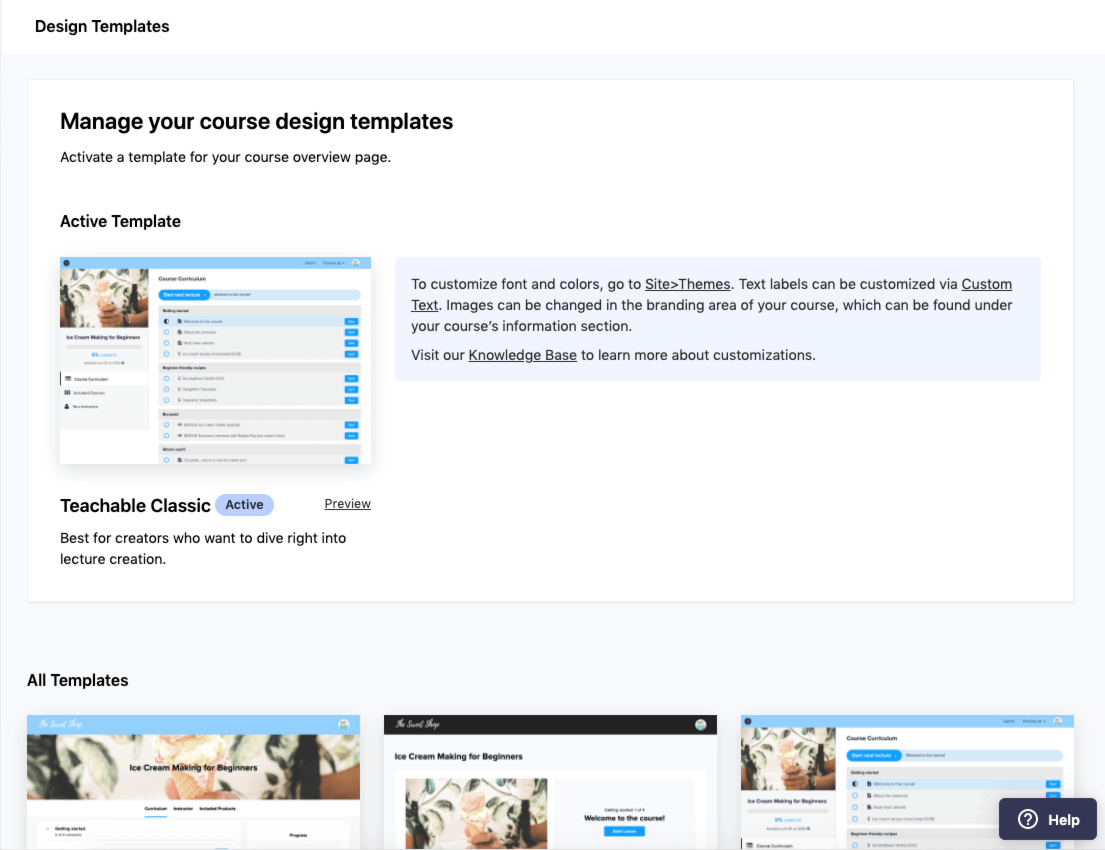
You will find all the features you will need to create your website:
To truly customize your website, you will need the highest plan in both Teachable and Kajabi, costing you $665 and $399 per month respectively.
While building a basic site with templates and a few drag-and-drop zones is user-friendly on both, creating a stunning website true to your brand will require html / css coding skills and a higher plan to unlock it.
Removing the branding for both plans would require at least the $159/m plan.
But beware! Teachable is never white-labeled. The reality is that every login and checkout screen goes through a teachable subdomain.
Whichever plan you have, you can’t truly white-label Teachable; it only removes the branding below.
💁 You can compare the white-labeling options of each platform in this article.
Mobile App
Both platforms have mobile apps for instructors and students, but neither offers a white-label version of their app only for your school. Both apps act as marketplaces including the company’s brand and are used to access courses from all instructors using the software.
It’s important to note that the Teachable app is only available on iOS devices.
If you have an Android device or you don’t want to exclude a large number of students from enrolling in your courses, consider choosing Kajabi.
Kajabi’s mobile app is available for iOS and Android, making the platform more versatile.
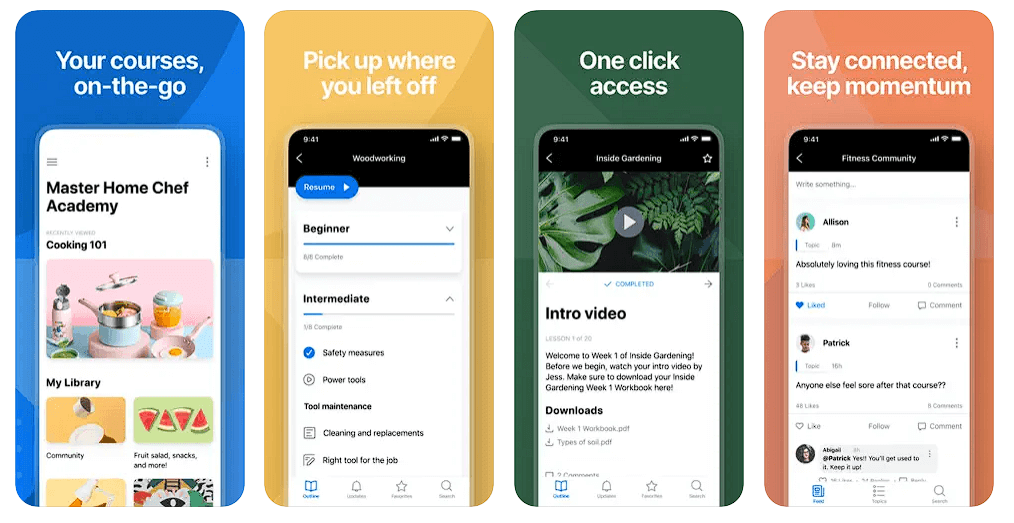
A marketplace app means that your courses are under Kajabi’s or Teachable’s brand and are shown side-by-side with your competitors.
💡 Only LearnWorlds offers a truly white-labeled mobile app.
Build the perfect branded mobile app for your academy. Instantly.
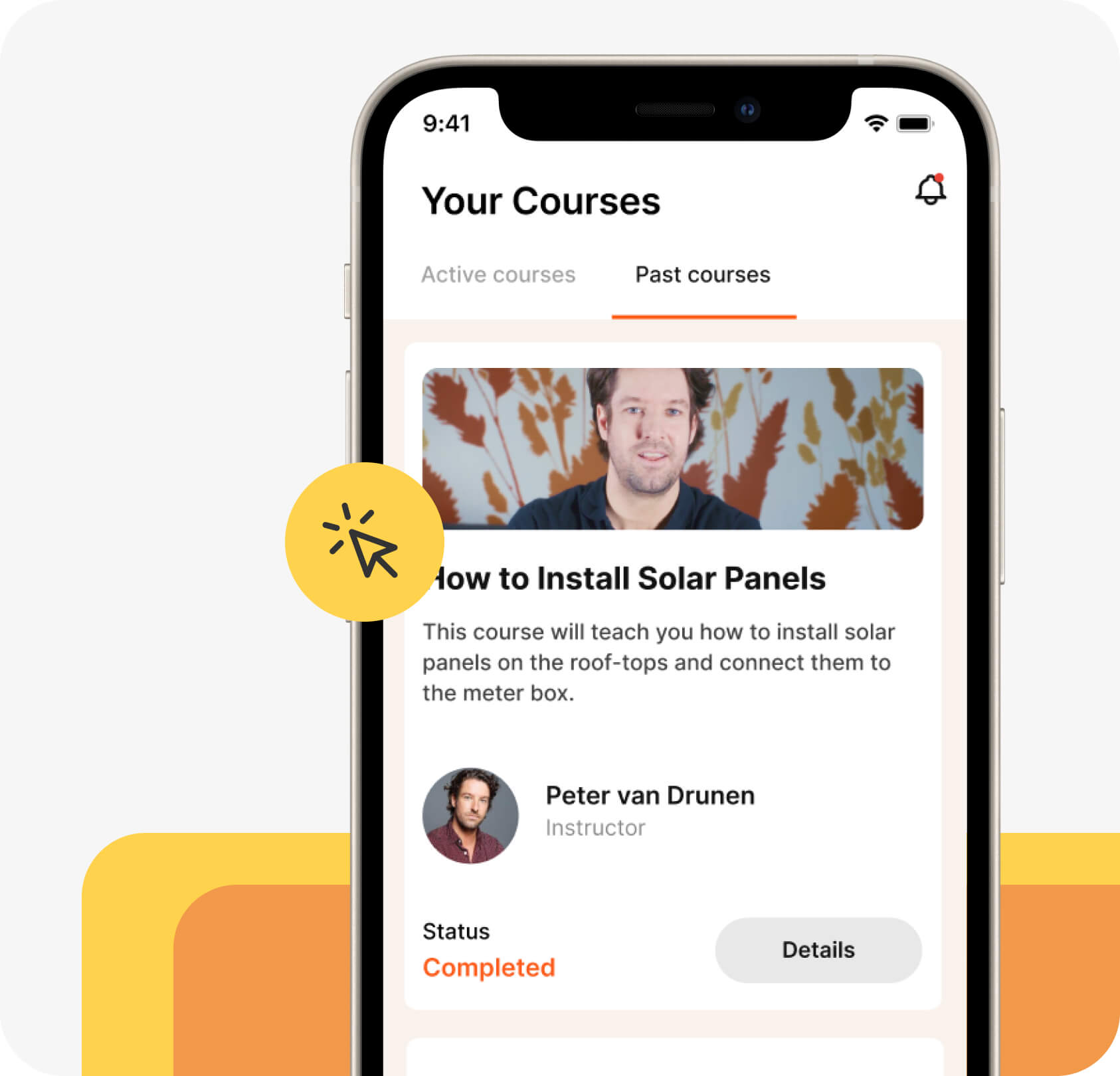
Integrations
Integrations allow you to use third-party websites and applications in conjunction with an online course platform.
Kajabi doesn’t have many integrations, but that’s because it’s an all-in-one platform with many built-in functions. As of May 2023, you can use the following tools with Kajabi:
Teachable has even fewer integrations than Kajabi. You can use the course platform with these tools:
The good news is that both platforms integrate with Zapier as an intermediary, which allows you to integrate thousands of other software with your course platforms.
Customer Service
Kajabi wins Teachable in terms of customer service, as the platform offers 24/7 live chat support with its Growth and Pro plans. Teachable offers email support between 8 a.m. and 8 p.m. EST each day.
Teachable’s customer support receives a lot of negative comments on review sites, while Kajabi seems to offer decent support.
I have to note here that Kajabi’s plans start at higher prices, and it makes sense to have better support for the software you are paying more for.
Both platforms have self-service libraries (knowledge bases), videos, blogs, and courses filled with answers to frequently asked questions and tips for succeeding with online course creation. You will find a lot of useful material to grow your business and how to use the platform.
Pricing Plan Comparison
Both Kajabi & Teachable offer three paid plans and an option for custom pricing for enterprise users.
Teachable also offers a Free-forever plan, while Kajabi does not offer a free plan. However, Teachable’s free and basic plans come with steep transaction fees.
Kajabi offers a 14-day trial but requires a credit card as well. You need to be confident you want to use Kajabi to try it.
For the pricing table below, we are comparing the pricing of each software based on their monthly plans. Paying any plan yearly comes with an up to 20% discount on the total price.
Which One Is the Best: Teachable or Kajabi?
It really depends on how you plan to use the platform. If you are new to the market and building up your first business, Teachable is a better choice.
Signing up for a free-forever plan and being able to quickly set up payments with Teachable:Pay is great for beginners.
Kajabi is the best option if you want to scale your business. You can start with an online course, expand into a membership site, and then create a community filled with people who are eager to buy from you every time you release something new.
Kajabi also offers more built-in features than Teachable, eliminating the need to learn how to use multiple third-party applications.
The downside of Kajabi is that it’s expensive. If you are not already making some money, Kajabi might not be a good choice.
But our preferred choice is LearnWorlds. Our course platform is beating both in terms of price, quality, support, and learning features. Take LearnWorlds for a 30-day trial spin.
Your professional looking Academy in a few clicks
Start FREE TrialAlternatives for Kajabi and Teachable
If you’re not sold on Kajabi or Teachable, you have a few other options.
💡 Compare Kajabi Vs. Teachable Vs. Thinkific Vs. LearnWorlds.
FAQs
What’s the difference between Teachable and Kajabi?
The main difference between the two platforms is that Teachable focuses on educational and coaching features and less on marketing automations than Kajabi. You can use Teachable to create unlimited courses and provide one-on-one coaching to clients, but it isn’t designed for creating memberships or starting an online community.
Teachable has some third-party integrations, but it doesn’t have nearly as many marketing features as Kajabi. Therefore, Kajabi is a better choice for business owners who are concerned with scalability. Teachable offers a better user experience for those who have limited experience with course creation and want to focus on learning management rather than marketing.
Which one is better, Kajabi or Teachable?
It depends on your needs. Teachable is ideal if you’re just getting started with course creation and don’t have a ton of experience creating learning modules, setting course compliance requirements, or handling enrollments.
Kajabi is the better option if you want to use online course creation to grow your business. If you sign up for Kajabi, you should feel comfortable creating marketing campaigns, working with email marketing tools, and moving prospective customers through your sales funnel. Kajabi is also a good choice for business owners who want to launch online communities, create membership sites, or offer group coaching.
Does Kajabi own your content?
No. You retain ownership of everything you create, so you can update or delete your content at any time. Kajabi doesn’t own any of your course content.
What are Kajabi’s competitors?
Some of Kajabi’s top competitors include LearnWorlds, Thinkific, Teachable, and Karta. Out of these four options, LearnWorlds is the most robust. The cloud-based LMS platform comes with a suite of tools to help you create courses and market them to members of your target audience. LearnWorlds also has a site builder that makes it possible to create custom course designs instead of recycling the same few templates.
Does Kajabi offer hosting?
Yes, Kajabi offers hosting. Before you launch your website, you’ll need to purchase a custom domain from GoDaddy, Name.com, or another registrar.
Is Teachable cheaper than Kajabi?
In most cases, Teachable is cheaper than Kajabi. How much it costs depends on which plan you choose. The free plan has no monthly fee, but you’ll pay transaction fees of $1 plus 10% of every sale. If you upgrade to a paid plan, you’ll pay $59 to $665 per month to access the platform. The transaction fees drop to 5% once you’re enrolled in a paid plan.
Kajabi doesn’t offer a free plan, and its cheapest paid option is $119 per month. However, its top-tier plan is $399 per month compared to $665 per month for Teachable’s business plan. Kajabi doesn’t charge any transaction fees.
Nick Malekos is a Senior Digital Marketer in LearnWorlds. He is a results based and well-rounded Digital Marketer with years of experience in the education industry, writer and digital literacy trainer.

